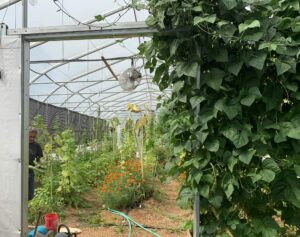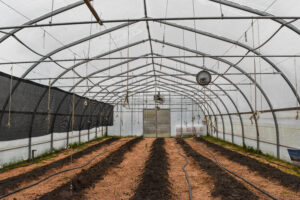4.1 Greenhouse Production
A Calendar Year
This calendar was informed by Fred Fortier, Uncle Freddy’s Hothouse (zone 5b).

Crops: Tomatoes, cucumbers, melons are the main crops in the greenhouse, and they are inter-planted with root vegetables, flowers (to attract bees), beans, fennel, onions, and garlic.
Planting methods: Use companion planting methods for plant health. You can also inter-plant as part of your Integrated Pest Management plan (e.g. to repel pests and attract insects who will eat your pests), and plant flowers to attract pollinators.
Season: 5b
The critical temperature for plants to survive is 10C, so when the ambient temperature in your greenhouse does not go below that, you can start planting. In a heated hothouse on March 1 start planting seeds, and in an unheated hothouse, on April 1 you can start planting seeds to sell as transplants that are ready to sell in 6 weeks.
January/February:
- Order seeds, soil, trays, equipment if necessary
March:
- Plant seeds in warm location (over 10C), starting with the ones with longer days to maturity starting around March 15
- Organize indoor supplies, fix any outdoor equipment weather permitting, etc.
- Greenhouses overheat easily, so make sure that soil stays moist
April:
- Everything is planted from seed that will be grown in the greenhouse by April 1
- Water and care for seedlings
May:
- Once the seedlings are large enough, plant seedlings in the soil in the greenhouse
- Brassicas can planted in the ground around May 15
- If any seeds were started in the greenhouse, plant everything outside in the fields
June
- Water, weed, maintenance, mulch, thin seedlings if necessary
- Harvest greens
July:
- Harvest garlic
- Water, weed, maintenance, mulch
August/September:
- Water, weed, maintenance, mulch
- Harvest
October:
- Harvest
- Every bed is planted with fall rye – no till method, chop it in squares, turn it over then plant into it

Value-Added Opportunities
Growing seedlings for sale in the Spring – Costs include trays, soil, seeds, and transportation
Key Resources
